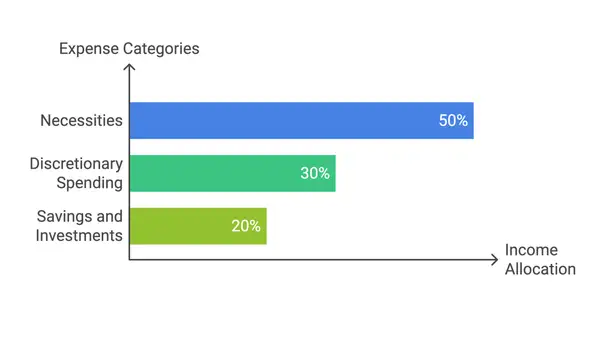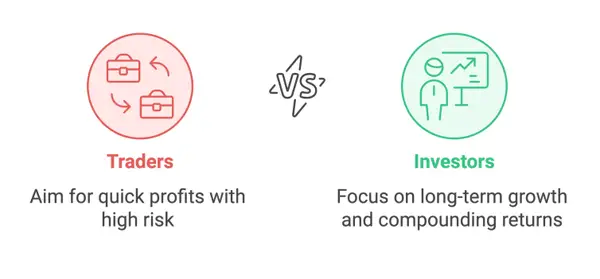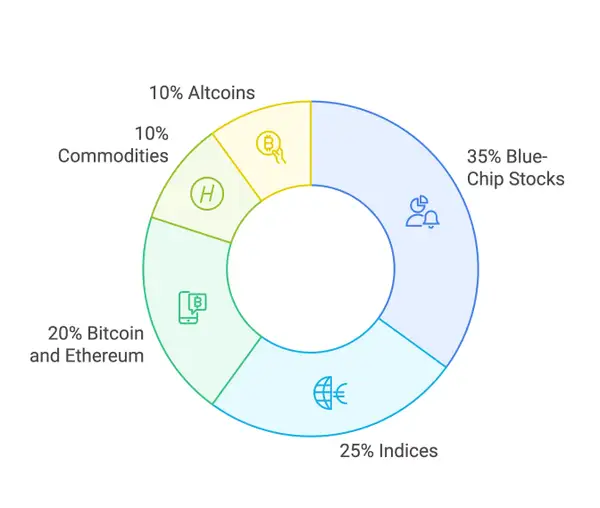Portfolio Diversification: Why and How Should You Do It?

Finance is deeply rooted in math, but investing often defies simple equations. In the world of dynamic markets, two plus two doesn’t always equal four. It can be five or even zero, depending on many internal and external factors. You could diligently invest money every month, only to find yourself with less than you started if you don’t play your cards right. Choosing the wrong assets or poorly timing your entries and exits can drastically shape your results.
That’s where portfolio diversification comes in. The old saying “don’t put all your eggs in one basket” rings true for a reason. It's a cornerstone of risk management. However, no one hands you a roadmap for which baskets to choose. While there are no guaranteed rules for consistent success, there are proven strategies and key principles you can rely on to optimize your portfolio and minimize risk.
What to Decide First When Creating a Portfolio
Building a strong portfolio starts with understanding your financial situation, goals, and risk appetite. These foundational decisions will shape your investment strategy and ensure your portfolio aligns with what you need.
Setting Out the Budget
The first step is deciding how much of your income or savings you’re willing to allocate for investments. The question to ask yourself: How much can I afford to invest?
A commonly recommended formula is the 50/30/20 rule:
 From that 20%, consider how much you’re comfortable setting aside specifically for investing.
From that 20%, consider how much you’re comfortable setting aside specifically for investing.
There’s one thing people often overlook when creating their investment portfolio: cash. A really important part of any kind of portfolio is ensuring you have liquidity. Life happens, unexpected expenses can arise at any time. You don’t want to sell your investments or close positions out of necessity. Keeping a portion of your funds in accessible cash reserves will save you from making decisions that could hurt your long term strategy.
Investment Horizon
Are you in it for the short term or the long haul? This decision will shape the structure of your portfolio. Before you answer, let’s clear up a common misconception: short-term investing isn’t as “short” as people often think, especially compared to a trader’s timeline. It’s important to know yourself and avoid unrealistic expectations, don’t fall into the trap of thinking you’ll get rich next month.

Once you understand where you stand, align your portfolio with your investment timeline:
- Short-term investing (1 year or less): This strategy focuses on assets with the potential for quicker returns but often involves higher volatility. It’s suitable for those comfortable with high risk in pursuit of high reward.
- Long-term investing (5–10 years): A longer timeline lets you weather market fluctuations, focus on steady growth, and take advantage of compound interest.
Your Risk Management Level
How much risk can you take? This is one of the most important questions to answer because it directly impacts your portfolio. Start by asking yourself:
How much can I afford to lose without it affecting my daily life?
What is my goal? Steady growth, stability, or aggressive returns?
How would I react if the value of my investments dropped tomorrow?
Your answers will help you assess your risk tolerance, which is key to deciding on asset allocation. For example, if you prefer stability, you might lean towards safer options like gold or established global indices. If you’re comfortable with more risk, you could allocate a larger portion to growth-oriented assets like individual stocks or cryptocurrencies.
Are There Rules for Risk Management?
While there’s no formula for guaranteed success, a widely accepted rule is the 5% Rule. Never allocate more than 5% of your portfolio to a single high-risk asset. This helps limit the impact of any one investment on your overall portfolio, keeping things balanced and reducing the chance of major losses.
Diversify Across Asset Types
Investing in different asset classes helps ensure that your portfolio isn’t overly reliant on the performance of any single market. Depending on your risk tolerance, you can choose a mix of assets to balance growth and stability. Here are some examples:
- Equities (Stocks): Ideal for long-term growth, though they can be volatile in the short term. Read our complete guide on investing in the stock market.
- Commodities (Gold, Oil): Often considered safe havens during market downturns. For instance, gold tends to perform well during economic uncertainty.
- Cryptocurrencies (Bitcoin, Ethereum): High-risk, high-reward assets suitable for those with a higher risk tolerance. Cryptos have shown significant growth potential but can be volatile.
The key is to assess your comfort level with risk. For example; a higher risk tolerance might lead you to allocate more toward equities and cryptocurrencies. On the other hand, a lower risk tolerance might encourage a heavier allocation to commodities or stable market assets such as indices.
Diversify Across Sectors
Within asset types, diversifying across industries is crucial to minimize sector-specific risks. Each industry reacts differently to global trends and events, so spreading investments ensures your portfolio remains resilient.
For example, during the COVID-19 pandemic, the travel and hospitality industry faced significant losses due to lockdowns and restrictions. Meanwhile, the technology sector boomed as demand for remote work tools, e-commerce, and digital entertainment skyrocketed.
For 2025, here are our three top picks for sector diversification:

Morpher is here to make diversification effortless and approachable. Sure, you can dive into individual stocks within these sectors, but if you're feeling unsure about picking the right ones, we've got your back. Morpher’s custom indices are designed to give you broad exposure to specific industries without the guesswork.
Take TECH, for example, this index features 25 carefully selected stocks, including industry giants like Apple, Tesla, and Cisco. It’s built for those seeking both stability and growth in one of the most exciting and transformative sectors shaping the future. Plus, it is zero commission. Test it yourself.
Diversify Globally
Limiting your investments to domestic markets can expose your portfolio to regional risks and miss opportunities elsewhere. Investing globally spreads your risk and gives you access to different economic growth patterns.
In recent years, the U.S. stock exchanges (such as the S&P 500) have experienced strong growth due to the dominance of tech giants like Apple, Amazon, and Tesla. Meanwhile, UK stock exchanges have shown slower growth due to uncertainties around Brexit and other economic factors.
Global diversification allows you to balance these differences, ensuring that a downturn in one region doesn’t heavily impact your overall portfolio. Investing in international markets can provide exposure to emerging markets with high growth potential and established economies with stable returns.
Step-by-Step Guide to Diversify Your Portfolio on Morpher
Generally, you have two paths depending on your risk appetite:
- For More Growth: Opt for higher-risk, high-reward assets like stocks or cryptocurrencies.
- For More Stability: Focus on safer options like gold or established market indices. Stability comes from prioritizing consistent, lower-risk investments.
For this guide, we’ll focus on a growth-oriented portfolio to illustrate how to create and diversify your investments on Morpher. Please note, this is purely for illustrative purposes and does not constitute financial advice. By asking yourself the questions outlined earlier, you can determine your own preferences.
Step 1: Deposit Your Budget
Morpher’s fractional trading allows you to invest in high-value assets like Tesla or Bitcoin without needing large sums upfront. For instance:
- You don’t need €400 to buy a full Tesla share; you can invest as little as €1.
- You can consistently add smaller amounts over time, building your portfolio gradually without any minimum deposit requirements.
Let’s assume you’re starting with €1,000.
Step 2: Analyze the Markets
Use Morpher’s real-time market insights to evaluate asset performance. Research trends, study historical data, and identify growth opportunities in key sectors and asset classes that align with your risk tolerance and goals.
Step 3: Build Your Portfolio

35% Blue-Chip Stocks: Invest in globally established companies for stability and consistent growth.
- Apple (AAPL): A leader in tech innovation and consumer electronics.
- Tesla (TSLA): Dominating the electric vehicle market with increasing global demand.
- Microsoft (MSFT): A key player in cloud computing and AI technologies.
25% Indices: Gain exposure to multiple sectors and global markets.
- AI Index (Morpher Custom Index): Captures the growth potential of artificial intelligence and automation.
- Global Market Indices: Includes promising indices from the US, UK, Germany, France, and Switzerland, such as the S&P 500 (US) and DAX (Germany). Visit this article for more details on indices trading.
20% Bitcoin and Ethereum: Allocate a reasonable portion to well established cryptocurrencies.
- Bitcoin (BTC): The leading cryptocurrency and a store of value.
- Ethereum (ETH): Dominates decentralized finance and smart contracts.
10% Commodities: Include stable assets to hedge against market volatility.
- Gold: A traditional safe haven during economic uncertainty.
- Natural Gas: An essential energy commodity with growth potential.
10% Altcoins (Remember the 5% rule!): Cap exposure to speculative assets.
- SUI: Focuses on scalability and speed with increasing adoption potential.
- Aptos: An innovative layer-1 blockchain for decentralized applications.
Step 4: Monitor and Rebalance
Markets evolve, and so do your goals. Regularly monitor your portfolio’s performance using Morpher’s tools. Adjust allocations as necessary to maintain balance or respond to market trends.
For example, if a sector underperforms, rebalance by shifting funds to promising areas or sectors with better potential.
Why on Morpher?
Because we don’t punish indecision or second chances. Especially when you’re just starting out, it’s completely understandable to feel unsure about your next move. That’s why we’ve made it our mission to make your life easier.
On Morpher, you won’t pay for any of your transactions. We operate with zero commissions, and there are no subscription fees or hidden charges tying you to your initial decision. You can practice, test things out, and find your own way, without worrying about costs or penalties.
If you heard enough, create your account.

Disclaimer: All investments involve risk, and the past performance of a security, industry, sector, market, financial product, trading strategy, or individual’s trading does not guarantee future results or returns. Investors are fully responsible for any investment decisions they make. Such decisions should be based solely on an evaluation of their financial circumstances, investment objectives, risk tolerance, and liquidity needs. This post does not constitute investment advice.

Painless trading for everyone
Hundreds of markets all in one place - Apple, Bitcoin, Gold, Watches, NFTs, Sneakers and so much more.

Painless trading for everyone
Hundreds of markets all in one place - Apple, Bitcoin, Gold, Watches, NFTs, Sneakers and so much more.









